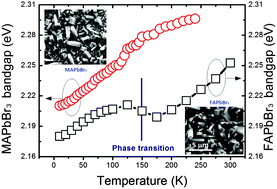Comparative investigation on temperature-dependent photoluminescence of CH3NH3PbBr3 and CH(NH2)2PbBr3 microstructures
Abstract
Organic–inorganic lead bromide perovskite is regarded as a highly efficient material for green light devices. In this study, we report on the fabrication of CH3NH3PbBr3 and CH(NH2)2PbBr3 perovskite microstructures. The morphologies and crystal structures of these two types of perovskite nanostructures are characterized and the differences in their photoluminescence behaviour are demonstrated. The temperature-dependent photoluminescence of the CH3NH3PbBr3 microstructure shows that exciton emission shifts continuously with increasing temperature and a trapped charge-carrier emission peak appears in the temperature region from 115 K to room temperature. Temperature-dependent photoluminescence of CH(NH2)2PbBr3 reveals a blue shift of the exciton emission with increasing in temperature, but there is a sudden red shift near 150 K due to phase transition. Temperature coefficients of the band gaps and exciton thermal activation energies of CH3NH3PbBr3 and CH(NH2)2PbBr3 microstructures are calculated. At room temperature, the exciton thermal activation energy of CH3NH3PbBr3 is higher than that of CH(NH2)2PbBr3, which indicates the excitons in CH3NH3PbBr3 are more stable.


 Please wait while we load your content...
Please wait while we load your content...